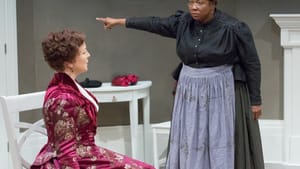Stay in the Loop
BSR publishes on a weekly schedule, with an email newsletter every Wednesday and Thursday morning. There’s no paywall, and subscribing is always free.
Miss independent
Arden Theatre Company presents Lucas Hnath's 'A Doll's House, Part 2' (second review)

The Arden Theatre company’s production of Lucas Hnath’s A Doll’s House, Part 2, currently the most produced play in the United States, begins like a student’s writing exercise. Imagine, you can almost hear a dramatic-writing professor say, what would happen if Nora Helmer returned to knock on the domestic door she once so forcefully slammed.
Under Tracy Brigden’s direction, a buzzer actually rings. But little else in this predictable staging of a predictable sequel surprises, or adds depth or substance to the source material. For those who know Ibsen’s original, it’s a winking, self-consciously clever 90 minutes; for those who don’t, it’s a fairly safe boulevard comedy trying too hard to be irreverent.
Of course, nothing written in 2017 could shock audiences the way A Doll’s House managed to in 1879. For the most part, Hnath doesn’t try to — his anachronistic use of profanity and slang seems inserted to provoke cheap laughs more than anything else. Instead, he distills the issues presented in Ibsen’s play — questions of independence, class, feminism, familial obligation, and romantic love — into facile sound bites, nodded at but never fully explored.
Welcome back?
Nora (Grace Gonglewski) has become a successful novelist, writing what was then called “women’s fiction” under a pseudonym. Her works draw heavily from her life, including her divorce from Torvald (Steven Rishard) and abandonment of her children. But, of course, there’s a rub — we learn in the opening moments that Torvald never actually filed their divorce, meaning all of Nora’s independent earnings could legally pass back to her husband.
Gonglewski cuts a regal figure in Olivera Gajic’s ornate costume, a deep mahogany silk dress with a plumed velvet shawl. She carries herself like a woman of the world, comfortable in her own skin and proud of what she’s achieved through her own ingenuity. She is at her best when Nora recalls her scrappy first months of sovereignty, working as a seamstress to support herself.
Elsewhere, Nora’s observations, and Gonglewski’s performance, turn glib. She baldly states that in 20 years, the concept of marriage will be entirely obsolete — a line that's only funny because, a century later, we know the opposite is true. A similar nudge inhabits her surety that the future will be kinder to women, especially those who choose to move through the world without the protection of a man.
More questionable are Nora’s interactions with her former nanny Anne Marie, played with warmth (and a heavy dose of ribald humor) by Joilet F. Harris. After raising Nora, Anne Marie raised Nora’s children in her absence, leaving her own impoverished family behind. In Ibsen’s original and Hnath’s sequel, Nora fails to fully grasp Anne Marie’s sacrifice, to say nothing of her lack of agency in the decision-making process.
Harris — who played Anne Marie in A Doll’s House at the Arden earlier this year — issues a potent rebuke when Nora claims a similarity in their situations. As a woman of means, Nora always had options that were never available to Anne Marie, who had to make shrewd choices to keep herself out of the gutter.

Privileged perspective
Hnath misses an opportunity to show that Nora, despite her personal liberation, still retains a heavy dose of privilege, to say nothing of cluelessness. Depth isn’t on the program.
Brigden struggles to suggest a sense of history among the characters, often moving the action at such a fleet clip the audience misses important points. At the performance I attended, what should have been a guaranteed laugh line — a quip about Nora having some experience forging documents — didn’t even get a chuckle of recognition.
Rishard brings an interesting intensity to Torvald, though he doesn’t fully capture the long-simmering resentment he holds toward his former wife. Hnath wrings a few laughs from Torvald not recognizing Nora upon his first entrance, but long after they’ve identified each other here, they still feel like strangers.
Nora’s daughter, Emmy, is a virtual stranger to her, although her absence has strongly influenced how the girl views the realities of life. Grace Tarves’s largely affectless performance lacks the cutting bite the character needs.
Jorge Cousineau’s scenic design resembles a downmarket version of the set he created for the Arden’s past production of A Doll’s House, its austere white walls stripped of life. That seems an apt metaphor for Hnath’s treatment.
But local audiences will have many opportunities to judge the play’s merits for themselves. The Arden’s production runs through December 9 — and George Street Playhouse, in nearby New Brunswick, New Jersey, opens its own staging November 27.
To read Mark Cofta's review, click here.
What, When, Where
A Doll’s House, Part 2. By Lucas Hnath, Tracy Brigden directed. Through December 9, 2018, at the Arden Theatre Company’s Arcadia Stage, 40 N. Second Street, Philadelphia. (215) 922-1122 or ardentheatre.org.
Sign up for our newsletter
All of the week's new articles, all in one place. Sign up for the free weekly BSR newsletters, and don't miss a conversation.

 Cameron Kelsall
Cameron Kelsall